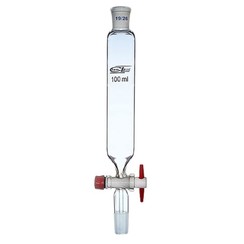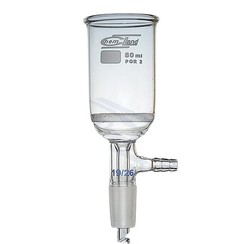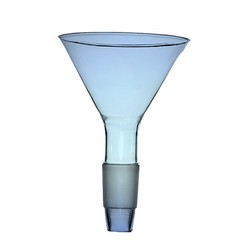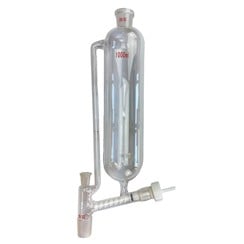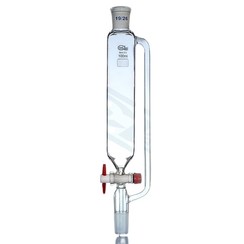You have no items in your shopping cart
Separating funnels / dropping funnels / filter funnels
Funnels are pieces of glassware that are often used in the laboratory to separate or add substances to reactions. There are many different shapes and can be divided into the types below
- Referees
Separating funnels are conical pieces of glassware often made from borosilicate glass. They are usually used to separate liquids that consist of 1 or more phases. If a mixture consists of 2 different liquids that are immiscible, they form two layers so that they can be separated by turning on the tap and collecting one of the liquids. Solvents can also be added to a separatory funnel to extract a substance from another solvent. It is also good to wash a liquid with a separatory funnel, for example by removing salts from an organic phase, water can be added. Because most salts are more soluble in water than in other solvents, the salt will go to the water after which the organic phase can be separated without being contaminated with salts. While shaking the liquids, it is always important to vent in the meantime, this can be done by turning the funnel upside down and opening the tap briefly to let the air escape.
-Drip funnel
A dropping funnel is used to add liquids to a reaction. dropping funnels exist in different shapes, there are drop funnels with a grinding piece, without a grinding piece or with pressure compensation. when a liquid has to be added slowly to a reaction, the dropping funnel can be coupled to a distillation set-up by means of a grinding joint. When the reaction takes place in a closed system, a pressure-compensated dropping funnel is required. If no pressure-compensated dropping funnel is used, all liquid will be drawn quickly into the reaction if there is negative pressure in the distillation equipment. The opposite, if there is excess pressure then little or no liquid will enter the reaction. A separate version of the dropping funnel is the powder addition funnel, it is intended to slowly add powders to a reaction, by turning the mold wheel, powder will slowly move to the reaction. Because the funnels are located in the closed system, the distillation equipment will not have to be opened to add substances to the reaction, so chemicals can be added during a distillation, for example.
-Filter funnel
A filter funnel is very similar to a Büchner funnel, but it has the advantage that the filter has melted into the funnel. The filter plate is made of porous glass and therefore inert to most substances. So you don't have to put new filter paper in the funnel every time, which saves a lot of money in the long run. The vacuum is also more constant because the funnel consists of 1 whole. With most variants of a filter funnel, the hose connection is fused, so no adapters are needed to connect a hose. The filter funnel can be placed on a round bottom flask or Erlenmeyer flask with a ground connection in which the liquid can be collected. A disadvantage of a filter funnel is that when it filters substances that are not soluble in most solvents, they get stuck in the pores and are difficult to get out. Filter funnels are available with different glass frits, from very fine to coarse. To be able to use a filter funnel, a vacuum pump is needed, this can be a water jet pump or a membrane vacuum pump. It is not wise to use a normal vacuum pump as they are not resistant to most chemicals. It is also important to choose the right hose because not all hoses can handle vacuum and chemicals well.



